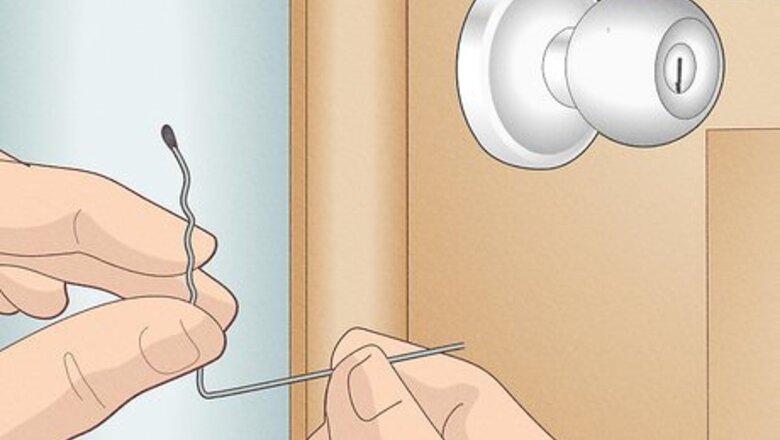
views
- Pick a keyed entrance doorknob using bobby pins folded into a lockpick and lever shape. Genuine lockpicks and a tension wrench will also do the job.
- Open privacy doorknobs using a straightened paper clip by inserting the clip into the knob's pinhole. Alternatively, use a small flathead screwdriver to do it.
- Use a credit card to open any locked doorknob by swiping the card to push back the door's latch. Cut a hook shape into the card for extra grip.
Bobby Pins
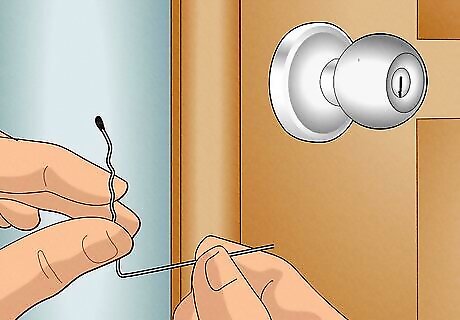
Bend one hairpin into an "L" shape and remove the plastic end pieces. Using your hands, keep bending a bobby pin open until the ends are ninety degrees apart—but be careful not to bend the pin too far and risk cracking the metal. Then, pull the end pieces off with a pair of pliers. You could also scrape them away with a butter knife or bite them off with your teeth if pliers aren't available. There are 4 main types of doorknobs (and lever doorknobs): keyed entrance, privacy, passage, and dummy. Passage and dummy knobs don't lock, while keyed and privacy locks are easy to distinguish! Before you get too far with this method, ensure the doorknob you're opening has a regular keyed entrance lock. A keyed lock has a keyhole and requires a key to unlock it.
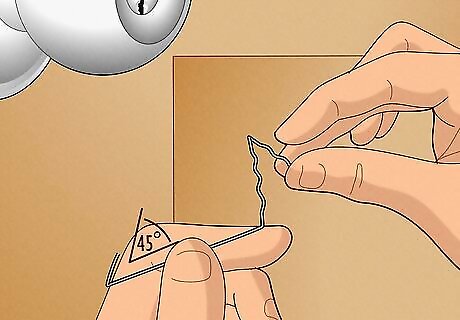
Fold one end of the pin at a 45-degree angle and the other into a handle. To get a 45-degree angle, insert the pin's flat end into the lock and slightly bend it to one side. Then, fold the other end in half over itself so that you have a small "V" shape (about a 20-degree angle) that acts like a handle. When finished, this pin will function as your makeshift "lockpick." Avoid over-bending the pin. It's not a 90-degree angle like before; it might look like a small curve, but that's to be expected.
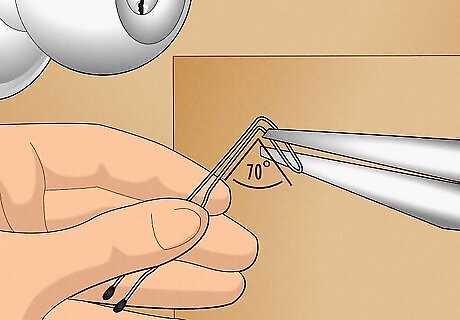
Grab a second hairpin and bend it about 70 degrees with pliers. You'll need 2 bobby pins total to unlock the door, and this one will function as the "lever" to assist your lockpick pin. Use a pair of pliers to bend the closed end of the hairpin at about 70 degrees. If you don't have pliers, use the same method you used for the first hairpin: stick the end into the lock and pull down until the hairpin is bent. Don't unfold this hairpin. Leave the pin as is, so both sides are bent 70 degrees.
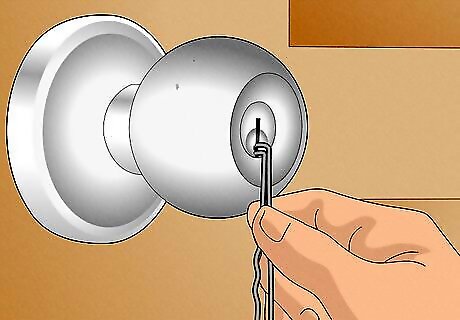
Insert the end of the second hairpin into the lock and turn it slightly. This is your lever pin, which will act as a guide for the lockpick and help you turn the lock once the pins are all pushed into place. Turn it gently in the same direction you would turn your key to unlock the door. You'll feel resistance as the lock catches on the pins, but keep up the pressure. While the closed end of the pin is in the keyhole, use the open end as your handle, allowing you to grip and turn the lever inside the lock.
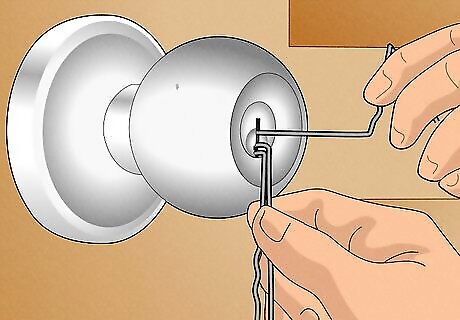
Slide your lockpick into the doorknob keyhole until you find a pin. Turn the arced end (at a 40-degree angle) to point upward before placing it in the keyhole above your lever hair pin. This allows the tip of the lockpick to push up pins. Use an up-and-down motion to push the lockpick forward and feel past each pin until you encounter a "seized" pin that won't move as easily as the rest. The locking mechanism for a keyed entrance doorknob contains pins that need to be manipulated into place for the lock to disengage. This is what your lockpick (or your makeshift bobby pin pick) is for. Be sure you're still applying pressure to the lock using your lever bobby pin while you do this.
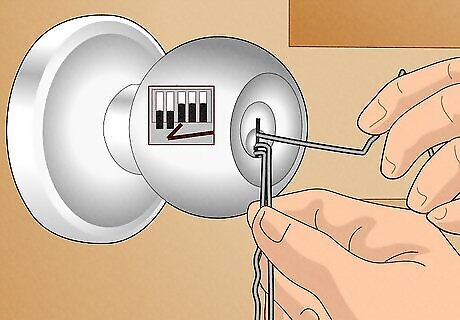
Work each seized pin until you hear a click. Move your lockpick up and down on the seized pin until you hear it click into place with the barrel. It's the sound of the barrel moving slightly to the side to prevent the lock from securing! However, once you've taken care of one pin, the next will become seized, so continue working on each pin the same way (moving up and down gently). Trust how the pins feel on the pick and allow it to direct your movements. It might take some practice, but eventually, it'll be easy to tell when you're on the right track just from the feel of the lockpick.
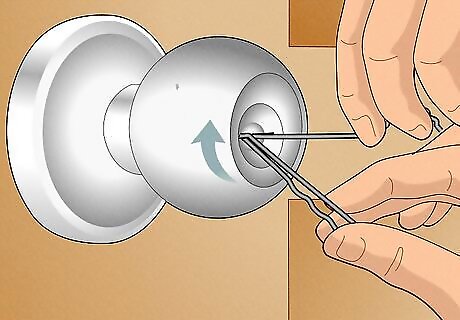
Open the lock by applying pressure while turning the lever. Once you feel like you've dealt with all the pins and felt them click, put more pressure on your lever (the second bobby pin). With that, the lock should open! If the lock doesn't open, you may have pushed one of the pins too high. Allow the pin to fall back down by easing the pressure on your lever. Be aware that releasing some pressure on your lever could also allow other pins to fall—meaning you might have to start over.
Credit Card
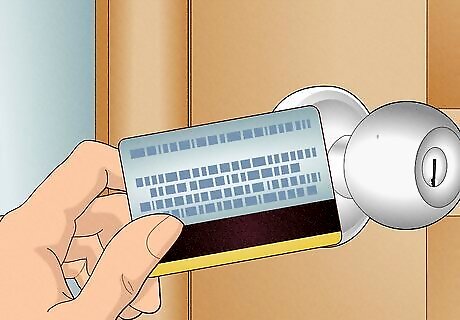
Choose a card that is old or easily replaceable. Using a credit card to pick a lock will certainly bend your card and potentially break it, so don't use anything you'll need soon after (unless it's an emergency). Save your debit or ATM card, for example; instead, pick an expired gift card, a store rewards card, or a credit card you don't often use that can be easily replaced. This trick will work with both types of door lock—keyed entrance and privacy lock! No need to differentiate before picking the lock. However, it's important to note that this won't work on a deadbolt lock. Only use it for doorknob locks and not the stronger deadbolt.
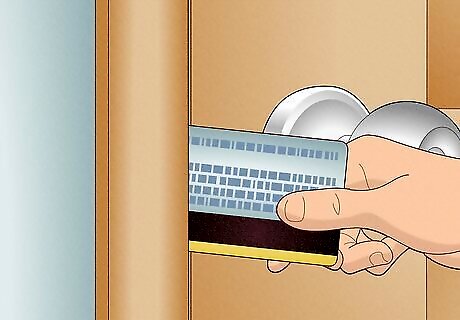
Insert the card between the door and frame of a spring bolt lock. Slide the card right next to the doorknob itself because that's where the lock's latch is—and the goal is to disarm the lock by releasing the latch. Bend a corner of the card gently before sliding it into place; the curve of the card will help you get it around the door quickly. The card will have to bend slightly to squeeze into the door frame and door crack. Just be careful—you don't want too much pressure to break the card.
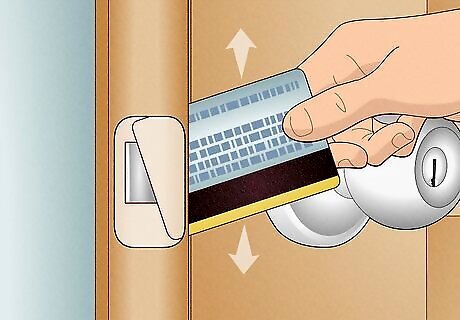
Push the card forward while moving it up and down. As you push and wiggle the card simultaneously, use the movement to catch the latch that's holding the door closed. Bend the card away from the door slightly to put pressure on the latch, forcing it away from the door frame. Then, turn the knob while pushing the card to disengage the lock and open the door! A door latch has a smooth side sloped at an angle, which is why you can slide the card up along that smooth side and push the latch inward.
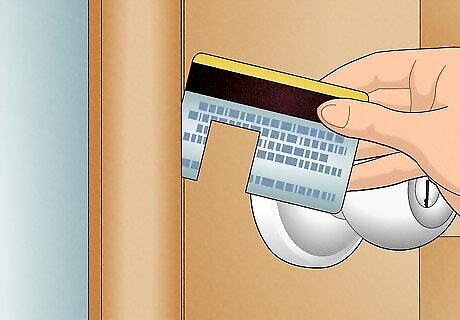
Cut the credit card and use it like a hook if the lock is difficult to catch. Position scissors near the end of the card on one of its long sides and cut halfway up the card. Create another parallel cut closer to the center of the card, and complete the hook by cutting away the loose plastic. Then, slide the card between the door and frame with the makeshift hook facing down and follow the steps above! Creating a hooked card (and sliding it into the door facedown) allows you to quickly catch the latch and pull it away from the door frame. Keep in mind that this will definitely ruin your card—but it'll also make it a lot simpler to open if you haven't mastered the credit card technique!
Paper Clip
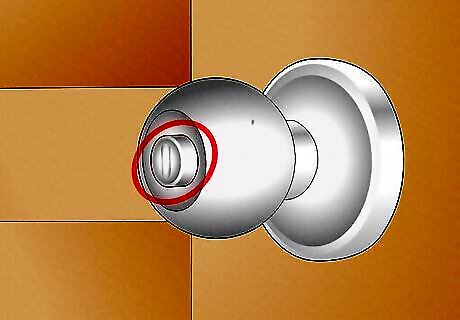
Verify that you’re working with a push-button doorknob. This is one type of privacy doorknob; the other most common type is the thumb-turn privacy doorknob. Push-button knobs have a button on one side that locks the door when pushed in, while thumb-turn knobs have a small button that turns to the side. The other side of both knobs has a tiny pinhole on it. Privacy doorknobs are commonly found on interior doors like bathrooms and bedrooms. Look for the pinhole to verify it's a privacy knob. If you don't see it in the center of the knob, check the knob's stem or the area where the knob connects to the door.
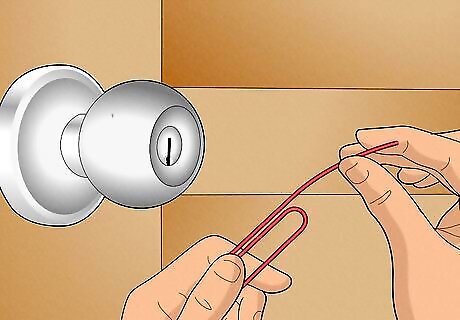
Unbend the outer wire of a paper clip to create your lockpick. The wire from a single paper clip is all you need to pick a privacy lock. Find a small paper clip and unbend it, pulling one end of the clip it's as straight as it can get it. You don't have to unfold the entire paper clip, but one side should be straightened. If you don’t have a paper clip on hand, you can use a hairpin, wire coat hanger, or any thin item that will fit inside the pinhole as an alternative.
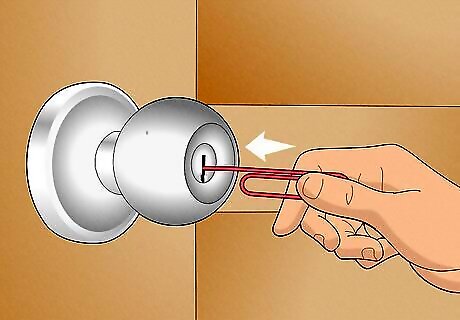
Stick the paper clip wire into the doorknob hole and push. Once you find the pinhole, line up your straightened paper clip wire with the hole. Push the clip forward into the hole, applying pressure until you feel it catch. Wait until you hear a click; the push button lock should open! Keep in mind that a keyhole (with an irregular shape) isn't the same as a pinhole (which is tiny and round). Keyholes have more complex locks, while you can open privacy knobs with a paper clip. If you're worried about locked bathroom or bedroom doors, you could invest in an emergency key, which is a simple metal "key" designed to fit interior privacy doorknobs universally.
Screwdriver
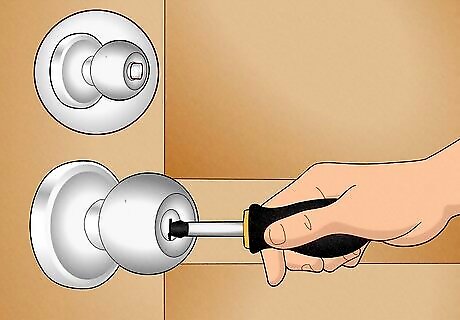
Insert a screwdriver into the pinhole of a thumb-turn-type privacy lock. If you have a thumb-turn doorknob (another type of privacy knob), find a small flathead screwdriver that is thin enough to fit in the pinhole. Slide it into place as far as it will go. Screwdrivers are a good alternative if you don't have a paper clip handy.
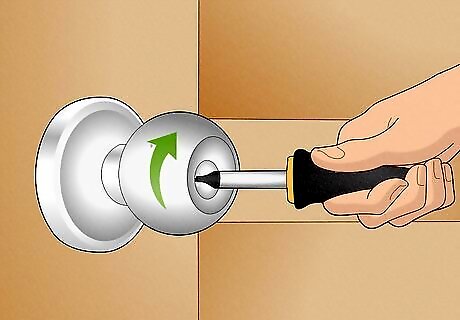
Rotate the screwdriver slowly until it falls into a groove. Once you feel the groove, start turning the screwdriver clockwise (right). Wait a few moments until you hear a click, then open the door as normal. Keyed entrance and privacy locks can be shaped like traditional doorknobs or lever doorknobs. The shape of the knob shouldn't matter so long as there's a visible keyhole or pinhole!
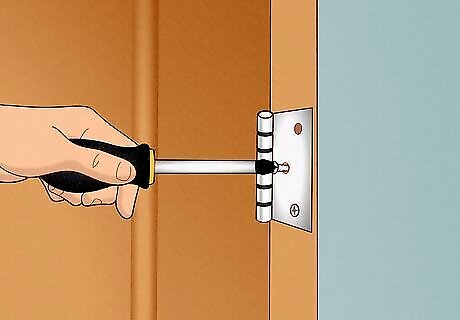
Use a screwdriver to remove the hinges on an interior door. If lockpicking isn't your cup of tea, another non-destructive way to open up a locked or damaged door is to remove its hinges. Locate the hinges (which should be outside of the door) and unscrew them using a screwdriver. Then, use the hooked end of a hammer to pull the screws out of the door frame. Keep in mind that this is definitely more time-consuming than picking a lock, so it should only be done if you have the tools and time to do a more extensive fix.
Tension Wrench & Lockpicking Tools
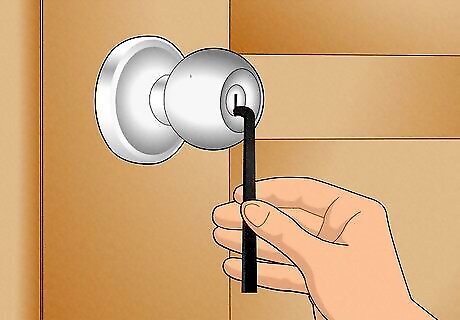
Insert a tension wrench into the bottom of the keyhole. Grab an L-shaped tension wrench, which is a flat strip of spring steel that bends at a 90-degree angle. Place the short end of the "L" into the keyhole and apply gentle pressure, turning in the direction you'd normally turn a key. You only need a couple of fingers to turn the wrench but don't be afraid to adjust your pressure when necessary. The tension wrench is your lever; it will rotate and put pressure on the lock while you manipulate the pins in the keyhole with your lockpick. Like the bobby pin method, use lockpicks and a torque wrench on a keyed entrance door (basically, a doorknob with a keyhole).
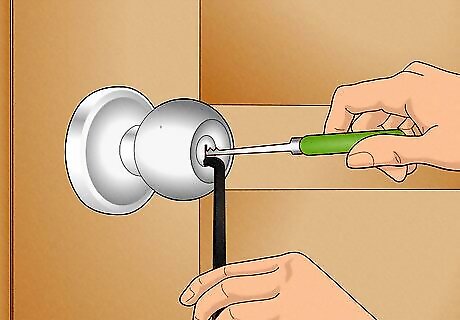
Slide a rake lockpick all the way into the keyhole above the wrench. With a rake lockpick, apply gentle upward pressure while moving the pick. Use the raking technique to wiggle it in-and-out and up-and-down simultaneously in a scrubbing motion and line up all the pins quickly. Keep up the rotating pressure with your tension wrench; once each pin clicks into place, the doorknob with open! Rake picks have a jagged shape that allows you to pick multiple lock pins simultaneously but don’t always work on complex high-security locks. Keyhole locks are typically made with 5 spring-mounted pins inside. The pins move up and down, though each is a different length. That way, the correct key pushes them into the proper formation, while the wrong key won't work.
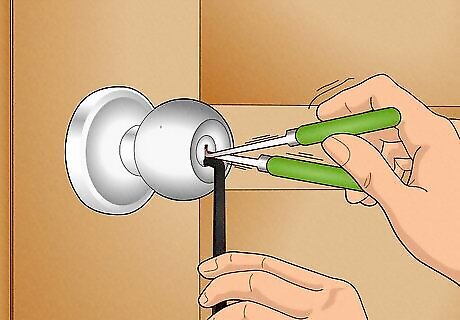
Insert a hook pick into the keyhole and work each individual pin. If you have a hook lockpick, slide it into the keyhole above your wrench with the hook facing up. Treat this lockpick much like you would with a bobby pin, using an up-and-down motion to work each lock pin separately until you hear a click. Keep turning your tension wrench; the door will open when the pins line up. Hook picks have a curved shape and only pick 1 pin at a time, but work on any lock. Choose from either a rake pick or a hook pick to unlock your door—or learn to use both! If you're unsure which to choose, many lockpicking sets come with both types of picks. Though the average household probably doesn't have lockpicks and a torque wrench lying around, you could always invest in these tools to be prepared for anything.



















Comments
0 comment